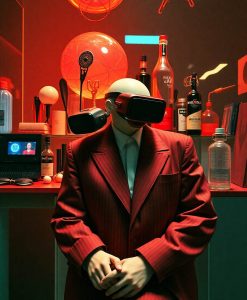Walking through a crowded city street, you might notice a blend of styles—some real, some digital. You see someone in a bold, shimmering jacket, but what if it’s not a jacket at all? What if the clothes you wear are entirely virtual, existing only in the digital space, yet influencing how you feel about yourself and how others perceive you?
This shift toward virtual-only couture isn’t just about changing trends; it touches on something deeper—how we define personal style and self-expression in a world increasingly mediated by pixels. As fast fashion keeps fueling landfills and environmental concerns, the idea of digital fashion offers a new way to think about clothing—one that could be more sustainable, more personalized, and more expressive than ever before.
Understanding the rise of virtual fashion and its impact on identity
Many of us are familiar with the thrill of trying on new outfits or updating our wardrobe for a special occasion. Now, imagine that thrill carried into the digital realm, where your avatar’s wardrobe becomes a limitless canvas. Virtual-only fashion allows you to experiment with styles that might be impossible or impractical in the physical world—think shimmering holographic dresses or avant-garde looks crafted from pure pixels.
This emerging trend isn’t just about novelty; it’s about redefining what it means to wear clothing. When your digital self can don a new outfit instantly, without the environmental cost of production or waste, it shifts the relationship we have with our personal style. For many, this is a way to express their unique identity—bold, quirky, elegant, or rebellious—without the constraints of physical fabric or societal expectations.
Why virtual fashion could be the future of sustainable style
Fast fashion’s rapid cycle of production and disposal has created a global environmental crisis, filling landfills with cheap, disposable clothing. Virtual-only couture offers a compelling alternative. Since digital outfits require no physical materials, they eliminate waste, reduce carbon footprints, and democratize access to high-end, creative fashion. Someone in a small town can wear a runway-worthy digital ensemble, while reducing their impact on the planet.
For those seeking more sustainable ways to express their style, virtual fashion becomes an eco-conscious choice. It also opens doors for innovation—designers can push boundaries without the cost of materials or manufacturing, creating more imaginative and inclusive fashion statements. In this sense, pixels might be the new fabric—limitless, adaptable, and free from the environmental toll of traditional clothing.
How virtual clothing is changing social interactions and online identity
As virtual-only fashion gains popularity, it influences how we connect and communicate online. Your digital wardrobe becomes part of your social identity—visible in video calls, social media profiles, or virtual worlds. The clothes you choose can signal your personality, mood, or cultural affiliations, shaping how others see you in the digital space.
This evolution prompts us to ask: could virtual fashion help foster a more inclusive, creative, and authentic online community? It offers a space where self-expression isn’t limited by physical constraints, and where everyone can explore different facets of their identity without judgment or expense. For some, this might mean a new freedom—wearing whatever feels true to them, in pixels, without the worry of physical limitations or societal expectations.

Ultimately, the idea that virtual-only couture could be the next clothing craze reflects a broader shift—one that merges technology with personal identity, sustainability, and creative expression. As digital fashion continues to evolve, it might fundamentally change how we see ourselves and others, both online and offline.
Learn More: Is virtual-only couture the new clothing craze?
Abstract: As fast fashion continues to fill wardrobes and landfills at a staggering pace, new research suggests that the future of fashion might lie not in fabric, but in pixels.
Link: Read Full Article (External Site)
